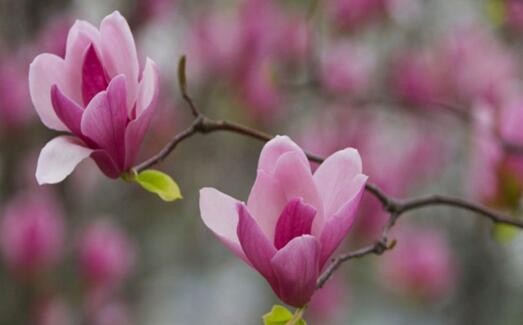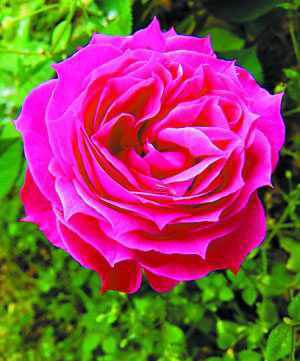How to cultivate Magnolia scientifically?
1. Soil. Rotten leaf soil and vegetable garden soil can be mixed and cultivated in the same amount, and 50g bone meal or nitrogen, phosphorus and potassium compound fertilizer can be added to the soil. The basin should be a little deeper and bigger, and the bottom of the basin should be put into some broken hard plastic foam blocks to enhance air permeability and drainage and prevent rotting roots. Turn the pot and change the soil once a year or every other year after flowering, keeping the persistent soil of 1x3pm and 1x2.
2. Watering. It is important to water at the right time. The Beginning of Spring to the flowering pot soil to keep moist but not wet, after flowering to keep moist but not waterlogged, after defoliation to keep slightly moist but not dry. Do not be dry or waterlogging at any time, especially in the rainy season.
3. Fertilization. It is necessary to seize the two key opportunities of February before flowering and May after flowering, and apply secondary nitrogen, phosphorus and potassium compound fertilizer in 10 days. Fertilization made buds expand and flowers bloomed in February, while fertilization promoted more pregnant buds in May, and there were more spring flowers in winter. When the leaves fall in winter, the fertilizer mainly composed of phosphorus and potassium is applied once to enhance its cold resistance and winter ability, and little or no application is applied in the rest of the time. Do not apply nitrogen fertilizer alone.
4. Light. Placed in the sunny courtyard, roof garden maintenance, most of the sun grows strong and luxuriant. Although it can grow under semi-overcast condition, it is thinner and has less flowers, while if it is overcast, there are no flowers. Purple magnolia is more hardy and can survive the winter outdoors in southern areas.

At the bottom of the valley in China, Magnolia is a very valuable flower, which is mainly used to watch flowers, so what is the language of Magnolia? The answer is: "fragrant feelings, handsome manners", because it is famous for its elegant fragrance and graceful posture.
What does purple magnolia stand for?
Purple magnolia means to appreciate each other, because when it is budding, it looks like a straight brush. If you give purple magnolia to each other, it means to praise each other's talent and express appreciation.
How long is the flowering period of Magnolia?
Botanists have found that the flowering time of Magnolia is usually in spring, that is, from March to April, and the flowering time is greatly affected by the temperature. For example, Magnolia Magnolia cultivated in a greenhouse may blossom in March, while open-field cultivation will blossom in April.
How do purple magnolia blossom
1. Rational fertilization
The number of flower buds is directly related to the number of purple magnolia flower branches. the more flower branches, the more buds may be, and the more flowers will bloom, which requires reasonable fertilization, such as applying compound fertilizer every 10 days before flowering. It can promote the growth of flower buds. Please refer to the detailed introduction of how to apply fertilizer to Magnolia.
2. Scientific pruning
Many plants need to keep the plant shape beautiful at ordinary times, but purple magnolia is not the case. Too much pruning will cut off some flower branches, so the pruning method of purple magnolia is particularly important. Generally, branches that are more than 15cm long and too dense need to be cut off after flower shedding, but do not need to be cut as they grow.
3. Control light and temperature
As we mentioned earlier, the flowering of Magnolia is mainly affected by temperature, so controlling the temperature at 15-20 degrees can make it blossom more. In addition, there should be plenty of light, and the best place to plant is sunny base fertilizer. In a semi-shady environment, it will have few flowers, and if it is too dark, it may not blossom.
What about the growing insects of Magnolia Magnolia? pest control / fertilization is the key.
The cold tolerance of Magnolia is very good, so it has fewer diseases and insect pests, but if the cultivation of Magnolia is completely wrong, or if the environment is too bad, it will cause pests and disease spots to harm Magnolia. What about Magnolia magnolia? Let's take a look at the pest control of Magnolia.
Pest control of Magnolia mandshurica
Diseases of Magnolia mandshurica
1. Yellowing of Magnolia
Main symptoms: the leaves of Magnolia Magnolia gradually change from green to yellow, the chlorophyll decreases gradually due to pathological changes, the leaves turn yellow at first and then turn white gradually, the growth of the plant is slow, and in serious cases, it may lead to plant death. it is one of the most harmful diseases in the prevention and control of diseases and insect pests of Magnolia.
Etiology: chlorosis is generally caused by bacteria, viruses, nematodes, etc., and can also be caused by insufficient nutrients, such as nitrogen deficiency, sulfur deficiency, drought, etc.
Prevention and control measures: strengthen cultivation management, pay attention to reasonable fertilization, timely watering, etc.; check the soil before planting, if the quality is too poor, should be improved by fertilization and other measures. In addition, 0.1% ferrous sulfate solution can be used for blade spray to prevent.
2. Anthracnose of Magnolia
Main symptoms: nearly round or irregular disease spots appear on the leaves of Magnolia Magnolia, often on the leaf edge, with a diameter of 10-20 mm. The disease spots are gray at first, the edges are dark brown, and then there are dense black dots.
Causes: high temperature, poor ventilation, less fertilization and watering, leaves infected by microsporum, black spots are bacteria.
Prevention and control measures: ① should pay attention to reasonable maintenance, such as scientific fertilization, watering, keeping the environment ventilated to avoid excessive ambient temperature; ② found diseased plants and sprayed 50% topazine wettable powder 500-600 times in time. Or 50% carbendazim 500-600 times solution, or 1 2ju 150-200 times Bordeaux solution, or 50% carbendazim 800 times solution.
Second, purple magnolia pest
1. Red spider
Red spider is one of the most harmful pests in the pest control of Magnolia Magnolia. After spreading its leaves, it will transfer to the leaves, starting from both sides of the main veins on the back of the leaves, with leaves as the main source of food.
Control measures: when ① finds that the color of the leaves is wrong, it should carefully check the back of the leaves, and if a small number of pests appear, remove the diseased leaves as soon as possible; ② uses 40% dicofol EC 1000mm 1500 times, 20% chlorpromazine wettable powder 2000 times to spray to remove pests.
2. Frost moth
The frost moth usually forages in the early morning, but lurks in the shade during the day, feeding on the epidermis of Magnolia leaves, and then the whole leaf may be eaten up, not only the growth of the plant will be hindered, but the flowering will be reduced.
Control measures: ① regularly turn the soil, can kill the overwintering pupae; when the frost moth is more serious in ②, it can be sprayed with 20% rice full suspension agent 1500 to 2000 times, 50% zinc parathion 2500 times, and 80% dichlorvos EC 800 to 1000 times.
- Prev

How to turn the pots and prune the eight Immortals?
Potted eight Immortals have to turn the pot and change the soil once a year. It is appropriate to turn the basin and change the soil in the first ten days of March. The new soil was prepared according to the proportion of 4 parts of leaf soil, 4 parts of garden soil and 2 parts of sandy soil, and proper amount of rotten cake fertilizer was added as base fertilizer. When changing pots, the roots of the plant should be pruned, cutting off rotten roots, rotten roots and overgrown roots.
- Next

Cultivation of Chinese rose
There are many cultivation methods of rose, among which cutting and grafting are the most common. The main method of grafting is bud grafting. The method of cutting propagation is introduced below. 1. Cutting period. Rose seedlings are mostly raised in spring and autumn, starting in late April to the end of May in spring, and from late August to the end of October in autumn.
Related
- Fuxing push coffee new agricultural production and marketing class: lack of small-scale processing plants
- Jujube rice field leisure farm deep ploughing Yilan for five years to create a space for organic food and play
- Nongyu Farm-A trial of organic papaya for brave women with advanced technology
- Four points for attention in the prevention and control of diseases and insect pests of edible fungi
- How to add nutrient solution to Edible Fungi
- Is there any good way to control edible fungus mites?
- Open Inoculation Technology of Edible Fungi
- Is there any clever way to use fertilizer for edible fungus in winter?
- What agents are used to kill the pathogens of edible fungi in the mushroom shed?
- Rapid drying of Edible Fungi

